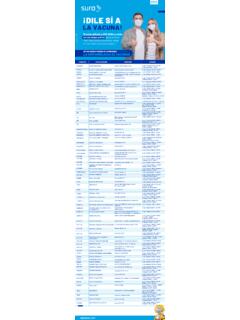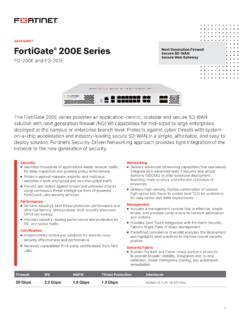Transcription of © Blend Images / Alamy 14 - Amherst College
1 14. Blend Images / Alamy Logistic Regression Introduction The Logistic The simple and multiple linear regression methods we studied in Chapters 10. Regression Model and 11 are used to model the relationship between a quantitative response variable and one or more explanatory variables. In this chapter, we describe Inference for similar methods that are used when the response variable is a categorical Logistic Regression variable with two possible values, such as a student applicant receives or does not receive financial aid, a patient lives or dies during emergency surgery, or your cell phone coverage is acceptable or not. In general, we call the two outcomes of the response variable success''.
2 And failure'' and represent them by 1 (for a success) and 0 (for a failure). The mean is then the proportion of 1s, p 5 P(success). If our data are n indepen . dent observations, we have the binomial setting. What is new in this chapter LOOK BACK. is that the data now include at least one explanatory variable x and the prob . ability p depends on the value of x. For example, suppose that we are studying binomial setting, whether a student applicant receives (y 5 1) or is denied (y 5 0) financial aid. p. 312. Here, p is the probability that an applicant receives aid, and possible explana . tory variables include (a) the financial support of the parents, (b) the income and savings of the applicant, and (c) whether the applicant has received finan.
3 Cial aid before. Just as in multiple linear regression, the explanatory variables can be either categorical or quantitative. Logistic regression is a statistical method for describing these kinds of 14-1. 14-2 Chapter 14 Logistic Regression The Logistic Regression Model When you complete Find the odds from a single probability. this section, you will Describe the statistical model for logistic regression with a single be able to: explanatory variable. Find the odds ratio for comparing two proportions. Binomial distributions and odds In Chapter 5 we studied binomial distributions, and in Chapter 8 we learned how to do statistical inference for the proportion p of successes in the bino- mial setting.
4 We start with a brief review of some of these ideas that we will need in this chapter. EX A M P L E Recommend the service. Exercise (page 501) describes a survey of 250 customers of an automobile dealership. The customers were asked if they would recommend the service department to a friend. The number who responded Yes was 210. In the notation of Chapter 5, p is the proportion of customers in the population of customers from which the sample was drawn who would respond Yes to the question. The number of customers who would respond Yes in an simple random sample (SRS) of size n has the binomial distribution with parameters n and p. The sample size of customers is n 5 250, and the number who responded Yes is the count X 5 210.
5 The sample proportion is 210. p 5 5 250. LOOK BACK Logistic regressions work with odds rather than proportions. The odds are simply the ratio of the proportions for the two possible outcomes. If p is the pro- odds, p. 633 portion for one outcome, then 1 2 p is the proportion for the second outcome: p . odds 5. 1 2 p . A similar formula for the population odds is obtained by substituting p for p . in this expression. EX A M P L E Odds of responding Yes. For the customer service data, the proportion of custom- ers who would recommend the service in the sample of customers is p 5 , so the proportion of customers who would not recommend the service department 1 2 p 5 1 2 5 Therefore, the odds of recommending the service department are p.
6 Odds 5. 1 2 p . 5. 5 The Logistic Regression Model 14-3. When people speak about odds, they often round to integers or fractions. If we round to 5 5 5y1, we would say that the odds are approximately 5 to 1 that a customer would recommend the service to a friend. In a similar way, we could describe the odds that a customer would not recommend the service as 1 to 5. UsE YOUr KnOWLEdgE Odds of drawing a heart. If you deal one card from a standard deck, the probability that the card is a heart is 13y52 5 1y4. (a) Find the odds of drawing a heart. (b) Find the odds of drawing a card that is not a heart. Given the odds, find the probability.
7 If you know the odds, you can find the probability by solving the odds equation for the probability. So, p 5 oddsy(odds 1 1). If the odds of an outcome are (or 5 to 2), what is the probability of the outcome? Odds for two groups In Example (page 507), we compared the use of Instagram for young women and men. Using the methods of Chapter 8, we compared the proportions of female and male Instagram users with a confidence interval in (page 507). or significance test (page 512). EX A M P L E Comparing the proportions of female and male Instagram users. Figure contains output from JMP for this comparison. The sample proportion of women who are Instagram users is given as , and the sample propor- tion for men is The difference is , and the 95% confidence interval is ( , ).
8 We can summarize this result by saying, In INSTAGR. this sample of young adults, the percent of women who use Instagram is 17% higher the percent of men who use Instagram. This difference is statis- tically significant (P , ).''. Another way to analyze these data is to use logistic regression. The explan- atory variable is sex, a categorical variable. To use this in a regression (logistic or otherwise), we need to use a numeric code. The usual way to do this is with LOOK BACK an indicator variable. For our problem, we will use an indicator of whether or not the adult is a woman: indicator 510. variable, if the person is a woman p. 610 x5.
9 If the person is a man The response variable is the proportion of Instagram users. For use in a logistic regression, we perform two transformations on this variable. First, we convert to odds. For women, p . odds 5. 1 2 p . 5. 1 2 5 14-4 Chapter 14 Logistic Regression FIgUrE JMP output for the comparison of the proportions of female and male Instagram users, Example Similarly, for men we have p . odds 5. 1 2 p . 5. 1 2 5 UsE YOUr KnOWLEdgE Energy drink commercials. A study was designed to compare two energy drink commercials. Each participant was shown the com- mercials, A and B, in random order and asked to select the better one. There were 150 women and 140 men who participated in the study.
10 Commercial A was selected by 71 women and by 87 men. Find the odds of selecting Commercial A for the men. Do the same for the women. Find the odds. Refer to the previous exercise. Find the odds of selecting Commercial B for the men. Do the same for the women. The Logistic Regression Model 14-5. Model for logistic regression In simple linear regression, we modeled the mean my of the response variable y as a linear function of the explanatory variable: m 5 b0 1 b1x. When y is just 1 or 0 (success or failure), the mean is the probability p of a success. Logistic regression models the mean p in terms of an explanatory variable x. We might try to relate p and x as in simple linear regression: p 5 b0 1 b1x.




